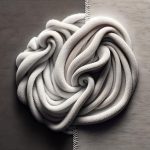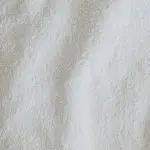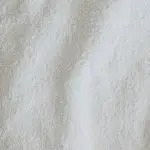Do you ever wonder what makes cotton terry fabric so unique? Well, look no further. In this article, we’ll delve into the history, characteristics, manufacturing process, and benefits of cotton terry fabric.
You’ll also discover the different types available and how it is commonly used. Plus, we’ll provide tips on how to care for and maintain your cotton terry fabric items.
Get ready to learn all about this incredible fabric and its sustainable production practices.
Table of Contents
History of Cotton Terry Fabric
The history of cotton terry fabric dates back to the early 19th century. It is a popular material known for its absorbency and softness. Cotton terry fabric is produced from cotton fibers, which are spun into yarn and then woven into a looped pile fabric. This looped construction gives terry fabric its signature plush texture and high absorbency.
Cotton terry fabric is widely used in the production of towels, bathrobes, and other household textiles. Its absorbent properties make it ideal for drying off after a bath or shower. Additionally, its softness adds a luxurious feel to these products.
In terms of production, cotton terry fabric goes through a series of steps. First, the cotton fibers are harvested and processed to remove impurities. Then, the fibers are spun into yarn and dyed to achieve the desired color. The yarn is then woven into terry cloth fabric using specialized looms. Once the fabric is woven, it undergoes finishing processes such as brushing and shearing to enhance its softness and appearance.
Characteristics of Cotton Terry Fabric
One of the main reasons people love cotton terry fabric is because it’s so soft and absorbent. But that’s not all this fabric has to offer. Cotton terry fabric is also known for its durability and longevity. It can withstand repeated use and washing without losing its quality. This makes it a great choice for items that need to stand up to everyday wear and tear, such as towels, bathrobes, and baby products.
In addition to its durability, cotton terry fabric is also highly versatile and has a wide range of applications. Due to its absorbency, it is commonly used for bath linens and accessories, as it can quickly and effectively dry the skin. Its softness and comfort make it a popular choice for clothing items like sweatshirts and loungewear. The fabric’s looped construction also makes it ideal for cleaning purposes, such as dish towels and cleaning cloths.
Overall, cotton terry fabric is a favorite among consumers for its softness, absorbency, durability, and versatility. Whether you’re looking for a cozy bathrobe, a plush towel, or a comfortable sweatshirt, cotton terry fabric is sure to deliver.
Manufacturing Process of Cotton Terry Fabric
Looping and weaving are two key processes in the manufacturing of cotton terry fabric.
During the looping process, the cotton loops are created, giving the fabric its characteristic plush texture.
Weaving, on the other hand, involves interlacing the loops to create a strong and durable fabric.
The result is a soft and absorbent material that is perfect for towels, bathrobes, and other cozy essentials.
Looping and Weaving
Weaving and looping techniques are used to create cotton terry fabric. This loop pile fabric is known for its softness and absorbency, making it ideal for towels and bathrobes.
Here are three key aspects of the looping technique used in cotton terry fabric production:
-
Loop formation: The looping technique involves the creation of loops on one or both sides of the fabric. These loops are formed by interlacing the weft yarns with the ground warp yarns, creating a raised pile texture.
-
Loop height: The height of the loops can vary, affecting the fabric’s absorbency and plushness. Longer loops create a more luxurious feel, while shorter loops offer enhanced durability.
-
Loop density: The density of the loops determines the fabric’s weight and thickness. Higher loop density results in a heavier fabric with increased absorbency, while lower loop density creates a lighter fabric suitable for warm weather.
Soft and Absorbent
To achieve a soft and absorbent texture, you’ll want to focus on the height and density of the loops in your cotton terry fabric production. Terry cloth towels, known for their high absorbency, are made using this technique. The loops in the fabric create extra surface area, allowing for greater absorption of moisture. By adjusting the height and density of the loops, you can control the softness and absorbency of the fabric.
Here is a table that illustrates the impact of loop height and density on the fabric’s characteristics:
| Loop Height | Loop Density | Fabric Texture | Absorbency |
|---|---|---|---|
| Low | Low | Rough | Low |
| Low | High | Soft | Medium |
| High | High | Plush | High |
Benefits of Cotton Terry Fabric
You’ll love the benefits of cotton terry fabric, such as its softness and absorbency. When it comes to towel material and bathrobes, cotton terry fabric is a top choice for a reason.
Here are a few reasons why:
-
Softness: Cotton terry fabric is known for its soft and plush texture. It feels gentle against your skin, providing a luxurious and comforting experience.
-
Absorbency: This fabric is highly absorbent, making it perfect for towels and bathrobes. It quickly wicks away moisture, drying you off effectively after a shower or bath.
-
Durability: Cotton terry fabric is known for its durability, making it a long-lasting option for your towels and bathrobes. It can withstand repeated use and washing without losing its quality or softness.
In addition to these benefits, cotton terry fabric is also breathable, allowing air to flow through and keeping you comfortable. It is easy to care for, as it can be machine-washed and dried.
Whether you’re wrapping yourself in a cozy bathrobe or drying off with a plush towel, cotton terry fabric ensures a comfortable and enjoyable experience.
Different Types of Cotton Terry Fabric
When it comes to absorbency, cotton is the go-to fabric. Its natural fibers have the ability to quickly soak up moisture, making it ideal for towels, bathrobes, and other items that need to be highly absorbent.
Terry fabric, which is made from cotton, is known for its looped, plush texture and is commonly used in towels, bathrobes, and even baby bibs.
Absorbency of Cotton
Cotton terry fabric is highly absorbent, making it perfect for towels and bathrobes. This fabric has the ability to soak up large amounts of moisture, making it an ideal choice for items that need to quickly dry you off. The absorbency of cotton is due to its unique structure, which allows it to hold water within its fibers. When you use a towel made from cotton terry fabric, the loops in the fabric trap the water and allow it to be absorbed, rather than just sitting on the surface. This moisture absorption helps to keep you dry and comfortable after a shower or bath.
Here is a table that compares the absorbency of cotton terry fabric to other common fabrics:
| Fabric | Absorbency Level |
|---|---|
| Cotton Terry | High |
| Microfiber | High |
| Linen | Moderate |
| Polyester | Low |
| Silk | Low |
As you can see, cotton terry fabric ranks high in terms of absorbency, along with microfiber. This makes it a popular choice for items that need to quickly and efficiently absorb moisture.
Uses for Terry Fabric
Towels and bathrobes made from this highly absorbent material are perfect for keeping you dry and comfortable after a shower or bath. Cotton terry fabric is widely used in the production of towels and bathrobes due to its excellent absorbency. The loops on the fabric’s surface create a soft and fluffy texture that is ideal for drying off.
Terry fabric is also known for its durability, making it a popular choice for everyday use. In addition to its functional benefits, terry fabric can be found in a variety of designs, from simple solid colors to intricate patterns. If you’re looking for alternatives to cotton terry fabric, options such as microfiber and bamboo terry are also available, offering their own unique qualities and benefits.
Common Uses of Cotton Terry Fabric
If you’re looking for a versatile fabric that is great for bathrobes and beach cover-ups, cotton terry fabric is a fantastic choice. Here are some common uses of cotton terry fabric:
-
Bathrobes: Cotton terry fabric is absorbent and soft, making it perfect for bathrobes. It can quickly absorb moisture from your skin, keeping you dry and comfortable after a shower or bath.
-
Towels: Terry fabric is widely used in towels due to its excellent absorbency. The loops on the fabric help to increase surface area, allowing the towel to absorb more water. Cotton terry towels are plush and soft, providing a luxurious feel.
-
Beach cover-ups: The absorbent nature of cotton terry fabric makes it ideal for beach cover-ups. It can quickly dry your skin after a swim and provide a comfortable barrier between your wet swimsuit and the outside world.
-
Baby products: Cotton terry fabric is gentle on delicate baby skin and is often used in baby towels, washcloths, and bibs. The soft loops of the fabric are gentle on sensitive skin, making it a popular choice for baby products.
With its versatility and properties, cotton terry fabric is an excellent choice for a wide range of uses.
Care and Maintenance of Cotton Terry Fabric
To keep your cotton terry items in good condition, it’s important to follow the proper care instructions. Cotton terry fabric is known for its absorbency and softness, making it a popular choice for towels, bathrobes, and washcloths. To ensure its longevity, there are a few key steps you should take when caring for your cotton terry items.
Firstly, always check the care label for specific instructions. Most cotton terry items can be machine washed with warm water and a mild detergent. Avoid using bleach or harsh chemicals, as they can damage the fabric and reduce its absorbency. Additionally, it’s best to wash cotton terry items separately from other fabrics to prevent lint transfer.
After washing, tumble dry on a low heat setting or line dry to preserve the fabric’s softness. High heat can cause shrinkage and damage the fibers. If necessary, you can use a low heat iron to remove any wrinkles, but be cautious not to apply too much heat.
Common problems with cotton terry fabric include pilling and color fading. To prevent pilling, avoid washing cotton terry items with rough fabrics like denim. To prevent color fading, wash them inside out and avoid prolonged exposure to direct sunlight.
Sustainable Practices in Cotton Terry Fabric Production
When it comes to sustainable practices in production, you can make a difference by choosing eco-friendly options. In the case of cotton terry fabric, there are several sustainable practices and production techniques that can be implemented to reduce environmental impact.
Here are some examples of sustainable practices and production techniques in cotton terry fabric production:
| Sustainable Practices | Production Techniques |
|---|---|
| Using organic cotton: | Using organic cotton that is grown without the use of harmful pesticides and fertilizers. |
| Water conservation: | Implementing water-saving technologies and processes to reduce water consumption during production. |
| Energy efficiency: | Utilizing energy-efficient machinery and practices to minimize energy consumption. |
| Waste reduction: | Implementing recycling and waste management systems to reduce waste and promote reuse. |
| Fair trade and ethical sourcing: | Ensuring that the cotton used in production is sourced from fair trade and ethical suppliers. |
Conclusion
In conclusion, cotton terry fabric is a versatile and durable material that has a long history and numerous benefits. Its soft and absorbent nature makes it ideal for various uses, from towels and bathrobes to clothing and home furnishings.
The manufacturing process involves weaving and looping, creating the characteristic loops that give terry fabric its unique texture. With proper care and maintenance, cotton terry fabric can last for a long time.
Additionally, sustainable practices in its production are being implemented to reduce environmental impact.
- Innovations in Moisture-Wicking Textiles - July 18, 2024
- Engineering Fabrics for Optimal Performance - July 18, 2024
- The Science of Breathability in Fabrics - July 18, 2024







